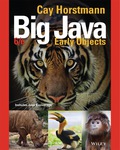
Explanation of Solution
Steps in the process of object-oriented design:
Step 1: Gather program requirements.
The development starts by collecting the requirements and its documentation.
Step 2: Discover classes.
The second step is to find the appropriate classes for the program. To find the classes, the user need to search for the nouns in the problem description.
Step 3: Determine the responsibilities of each class and identify collaborating classes.
In this step, use CRC card to determine the responsibilities of each classes ad their collaborating classes to solve these responsibilities.
Step 4: Determine the relationships between the classes.
In the fourth step, the user need to identify the relationships (Inheritance, Interface Implementation, Aggregation and Dependency) between the classes.
Step 5: Document the behaviour of classes using Javadoc comments.
In this step, the behaviour of the classes are documented using the “javadoc” comments.
Step 6: Implement classes.
In the final step, the user should generate the code for implementing the classes.
Want to see more full solutions like this?
Chapter 12 Solutions
EBK BIG JAVA: EARLY OBJECTS, INTERACTIV
 Database System ConceptsComputer ScienceISBN:9780078022159Author:Abraham Silberschatz Professor, Henry F. Korth, S. SudarshanPublisher:McGraw-Hill Education
Database System ConceptsComputer ScienceISBN:9780078022159Author:Abraham Silberschatz Professor, Henry F. Korth, S. SudarshanPublisher:McGraw-Hill Education Starting Out with Python (4th Edition)Computer ScienceISBN:9780134444321Author:Tony GaddisPublisher:PEARSON
Starting Out with Python (4th Edition)Computer ScienceISBN:9780134444321Author:Tony GaddisPublisher:PEARSON Digital Fundamentals (11th Edition)Computer ScienceISBN:9780132737968Author:Thomas L. FloydPublisher:PEARSON
Digital Fundamentals (11th Edition)Computer ScienceISBN:9780132737968Author:Thomas L. FloydPublisher:PEARSON C How to Program (8th Edition)Computer ScienceISBN:9780133976892Author:Paul J. Deitel, Harvey DeitelPublisher:PEARSON
C How to Program (8th Edition)Computer ScienceISBN:9780133976892Author:Paul J. Deitel, Harvey DeitelPublisher:PEARSON Database Systems: Design, Implementation, & Manag...Computer ScienceISBN:9781337627900Author:Carlos Coronel, Steven MorrisPublisher:Cengage Learning
Database Systems: Design, Implementation, & Manag...Computer ScienceISBN:9781337627900Author:Carlos Coronel, Steven MorrisPublisher:Cengage Learning Programmable Logic ControllersComputer ScienceISBN:9780073373843Author:Frank D. PetruzellaPublisher:McGraw-Hill Education
Programmable Logic ControllersComputer ScienceISBN:9780073373843Author:Frank D. PetruzellaPublisher:McGraw-Hill Education





